In this article, we bring to your attention a very successful project of a two-story bathhouse with a terrace, if you wish, you can later install a heating boiler and use the building all year round... The dimensions of the bath are 6x6 m, which makes it possible to have enough rooms for a comfortable stay. On the ground floor there is a steam room (3.4 m2), a sink (4.3 m2), a lounge (16.7 m2). The second floor is reserved for two bedrooms, one of them is large and designed for two people. Wardrobes for clothes can be placed in the hall on the second floor.
From the first to the second floor there is a marching rotating staircase.
A brief description of the design features and materials used for the two-story bath
For the manufacture of the log house, sawn timber 150 × 150 mm was used, the roofing was ondulin, the cladding of the internal and external walls was made of natural lining. For the facade, you can replace natural lining with cheaper materials.
Shallow reinforced tape foundation.
The lower strapping row is made of timber impregnated with antiseptics, 150 × 150 mm. For the lags, boards of 50 × 150 mm are required, the pitch of the lag is 60 cm. For the installation of the subfloor under the insulation of the first floor, skull bars 50 × 50 mm are attached, they are nailed on the sides of the floor beams.
The roof is insulated. Making an unused attic in a two-story bathhouse is inexpedient for economic reasons.
Mineral wool or glass wool is used as insulation.
It is worth talking a little about insulation. Manufacturers' advertising claims that only mineral "basalt" wool is the most the best material, it does not prick, does not cause allergic reactions, etc. Due to such "outstanding properties" of mineral wool, all manufacturers have significantly increased its price.
What is it really? Basalt contains more than 50% glass in its composition, it is this glass that is the main component basalt wool (as for glass wool), all other impurities are cleared. Then what is the difference in chemical composition between ordinary glass wool and mineral?
Further, why is glass wool pricking, but not mineral wool? And everything is simple here. Previously, technology did not allow glass fibers to be made very thin, so they had enough "strength" to create inconvenience. Today glass wool can be made with very thin fibers, it no longer splits. Another point that manufacturers do not talk about.
The cost of making glass is much more expensive than using ready-made volcanic glass (basalt). Then why is the price of mineral wool so much higher than glass wool? And everything is simple here. Advertising serves producers, not consumers. A competent advertising campaign made it possible to sell mineral wool at a much higher price than the production cost, and due to this, profits increase. We stopped at cotton wool only to convince you not to blindly trust advertising, but to think when choosing materials. Conclusion: not everything that is more expensive has better performance characteristics.
Video - Properties of Rockwool stone wool
For pediments, veneered boards 40 mm thick are used, cornices and corners of a log house are upholstered with clapboard. Four windows are installed in the gables, you can use plastic or make wooden ones. To make wooden windows yourself, you need solid knowledge and woodworking machines.
The two upper rows of log houses must be fixed with an increased number of dowels; it is better to use metal rods. The last row of the log house serves as a mauerlat and will perceive significant lateral loads from the rafter legs.
Under this material, a crate is made of slats of 20 × 50 mm, you can take unedged boards, used boards, left over after dismantling the foundation formwork, instead of slats. Ondulin is fastened with special nails, you need to drive in nails only into the upper part of the wave. It is imperative to put waterproofing under the ondulin, an overlap of at least 10 centimeters, the insulation is fixed with a stapler.
Step 2. The choice of the foundation. We propose to use a strip shallow reinforced foundation on a sand cushion.
The screw pile is quite good in all respects, this type of foundations can be used on any soil and in all climatic zones. The only drawback is that you cannot do it yourself, you need to contact specialized construction companies.
The advantages of a reinforced strip foundation on a sand cushion - at a shallow depth (within one meter), the building will be stable in various climatic zones. Sustainability provides sand pillow up to 30 cm thick. For reinforcement, you can use building reinforcement of a periodic profile Ø 8 ÷ 10 mm.
Step 3. Log house Fold the blockhouse from sawn timber 150 × 150 mm; tow or fiber can be used to insulate the crowns. There is not much difference in physical characteristics between these materials, but working with fiber is much easier and faster. In addition, the amount of shrinkage of the structure decreases, towards internal finishing works you can start faster.
First, a little physics. Hot air in the rooms on the ground floor rises to the ceiling and heats it up. The warm ceiling transfers "degrees" to the floor of the second floor and turns it into a "heated" one, and free of charge. The insulation prevents the floor of the second floor from heating up with free energy. The question is, why insulate the ceiling on the first floor in order to lower the temperature on the second with your own hands and your own money? We recommend doing insulation only in one case: the first floor is not heated, and the second has autonomous system heating. In all other cases, no additional insulation should not be done. This rule does not apply to the steam room, it has its own characteristics.
Step 6. Steam room and washroom. Here is high relative humidity air and temperature, wooden structures are in very difficult conditions. More recently, aluminum foil has become widespread among vapor barrier materials; it is strongly recommended to use it for all buildings without exception, including wooden ones. Manufacturers mention only one advantage of foil - absolute impermeability. They strongly recommend using it to isolate the steam room from condensation, it is advised to install foil between the wall cladding and the frame and between the ceiling cladding and rough ceilings.
What do the practitioners advise? Condensation will necessarily form on the foil due to the temperature difference and high humidity. Where will this condensate go? Continuously drip onto the finished headliner or drip onto the floor under the headliner. In this case, the slats to which the skin is attached, long time will be wet. It is not even worth talking about natural ventilation between the casing and the foil, even theoretically, it is completely absent in these places. What will happen to the constantly wet lining? That's it. We only advise and share our experience, the decision must be made by each developer independently.
In order to further facilitate your choice of construction technology, a few words should be said about all wooden buildings... Each article about these materials begins with the words that "wooden buildings breathe, this is their important advantage." Everything is correct. Only the tree does not "swallow air with its mouth", but is capable, due to the phenomenon of hygroscopicity, to transfer excess moisture from the premises to the outside and vice versa. If the humidity in the room is much lower than outside, then the tree gradually evens out the indicators. It is this process that should be borne in mind by the slang “the tree breathes”.
Due to these properties, the moisture content of wooden elements is constantly at optimal values, unless, of course, the builders put their hand to it. How can a wall made of natural timber breathe if its surface is hermetically sealed with aluminum foil? Why ordinary baths in villages have been standing for many decades, although during their construction none modern technologies and the materials were not used? During the renovation, only a few changes lower rims, and the bath is like new again. We don't even need to change the crowns, now there is an opportunity to soak them with antiseptics. You just need to choose the right technology construction works for each specific building and for each specific case.
"Liquid glassine" Processing of the lower rims and beams of the frame
We hope that now the acceptance algorithm will be clearer for you. optimal solutions during the determination of methods and materials for the construction of a two-story bath. Let's move on to one of the difficult structural elements - marching turning staircase.
The ability to make such a ladder is useful not only (and not so much) in the construction of baths, but in our case we cannot do without it at all. For manufacturing, you need boards of 50 × 200 mm, 40 × 200 mm and 25 × 150 mm. Balusters and handrails are best purchased in a specialized store or ordered from a professional master. All other work can be done independently.
Step 1. Calculation of the dimensions of the stairs.
Although this topic seems to be the most difficult for many, it is in fact the most simple work... During the calculations, the existing recommendations are taken into account: in total, the height and width of the steps should be ≈ 47 centimeters, the width of the steps ranges from 20 ÷ 32 cm, the height of the step ≈18 cm.The width of the steps is 30 cm and the height of the riser is 15 cm. .The angle of inclination of the stairs ≈30 °.
Step 2. Take measurements.
You need to know the height of the ladder, the length of the stringers, bowstrings and all the dimensions of the steps. Do not forget that the thickness of the boards is included in the dimensions. On one side, the bowstring rests against the supporting beam, on the other side, the stringers are fixed to the wall.
Step 3. Make a template of a step and a riser from plywood, estimate again their size and location.
Step 4. Cut out the blanks of the steps and risers under the template, grind the cuts, make chamfers and precisely adjust all the individual parts to the same size. In the bowstring, make landing sockets for fastening the steps. You can do them by hand (not very accurate for a long time) or use a handheld electric router.
Step 5. Using a plumb line and level, check the spatial position of the stringers and bowstring attachment points. Start in turn to install the steps on the seats. Make final adjustments to each element if necessary. Try to achieve such accuracy that the gaps in the joints disappear completely. Connect the elements of the staircase with self-tapping screws, recessed the heads and seal the holes. We strongly recommend that you additionally coat the joints with wood glue, this will be an additional guarantee that the staircase will not creak over time when walking.
Terrace
This is where the knowledge gained while making the ladder will come in handy. The length of our terrace is 3 m, width is 1.5 m, vertical supports from sawn timber 150 × 150 mm. The beam should be of the highest quality, select it for the supports even during the laying of the log house. Pay attention that there are no rotten knots and cracks on it, all four faces are parallel, there are no bends. The beam must be carefully sanded, sharp corners must be chamfered.
The railing to the uprights can be fastened into a thorn (a rather complicated method) or corners (the simplest method). We advise you to use corners, according to their physical characteristics, they are more reliable than a spike. In the lower part of the railing and supports, you need to cut out the corner seats with a chisel, work very carefully, the dimensions of the seats must correspond to the dimensions of the metal corners.
Video - Bath from a bar 6 x 6 m (turnkey)
Video - Do-it-yourself bath from a bar
Video - Bath from a bar with a terrace
When you conceived the construction of a bath, the question inevitably arises: "Maybe it is worth making it two-story?" If the budget allows and there is a desire, you can build two floors: with a slight increase in cost (by about 25-30%), you get almost double the area. Why almost? Because a considerable piece - at least two squares - will be "eaten" by the stairs. However, by moving the rest room to the second floor, you can make the rest of the bath rooms more spacious. But this solution has a drawback: the legs from habit after the runner up the stairs can "buzz". Because, probably, the rest room on the second floor is not often located. Usually there are living or guest rooms.
For each best project - yours. We all have different habits and ideas about how to properly take a steam bath. Someone prefers a dry-air sauna and needs a small steam room: it heats up faster. And someone prefers a cool Russian steam room, and even good work with a broom. The steam room should be bigger here.
Also relatively washing. There can only be a shower and a dousing bucket, and then a large area is useless. And sometimes they are installed in the washing room, some are even of considerable size. And there are also sinks with high temperatures - about 30-40 ° C. Then they put wooden trestle beds, such as shelves, and rest in the humid and warm air, without going into the cool (relative to these rooms) rest room. Then the areas should be appropriate.
How can you change the layout based on your preferences. This is a 6 by 3 sauna project, and in large sizes there are even more possibilities
But there are several rules that are universal:
- If you plan to use the bathhouse in winter, the front door should not lead directly to the relaxation room. There should be a closed vestibule. It can be attached, fenced off on the veranda or in the rest room. The dimensions are quite small - open the doors and enter, but this way the cold air enters the room much less.
- The doors to the steam room and washing room must open outward.
- For a Russian bath. That's right: two windows. One is opposite the door measuring 50 * 50 cm, the second is small under the shelf. These windows are needed not so much for lighting as for ventilation. Between entering the steam room, the main window and doors to the steam room must be opened and ventilated. Then prepare the steam room again. And the window under the shelves helps to ventilate the problem area itself after the bath, where problems usually begin.
- A washing window is also necessary. It also serves for ventilation, and also for evacuation. So here the dimensions should be slightly larger. If you are embarrassed that they will look into them, put patterned or opaque glasses. And the problem is solved.
- On the second floor, when planning premises, first of all, you need to determine where the chimney will pass, and how to fence it off.
Based on these rules, from any project that is more or less suitable for you, you can make your own ideal layout for the bath.
The project of the first floor of the bathhouse 6 to 6 + terrace
In this version of the layout of the bath, the vestibule is already fenced off. It will be possible to make or put a wardrobe for storing outerwear or bath accessories. The staircase is in the far corner of the break room.
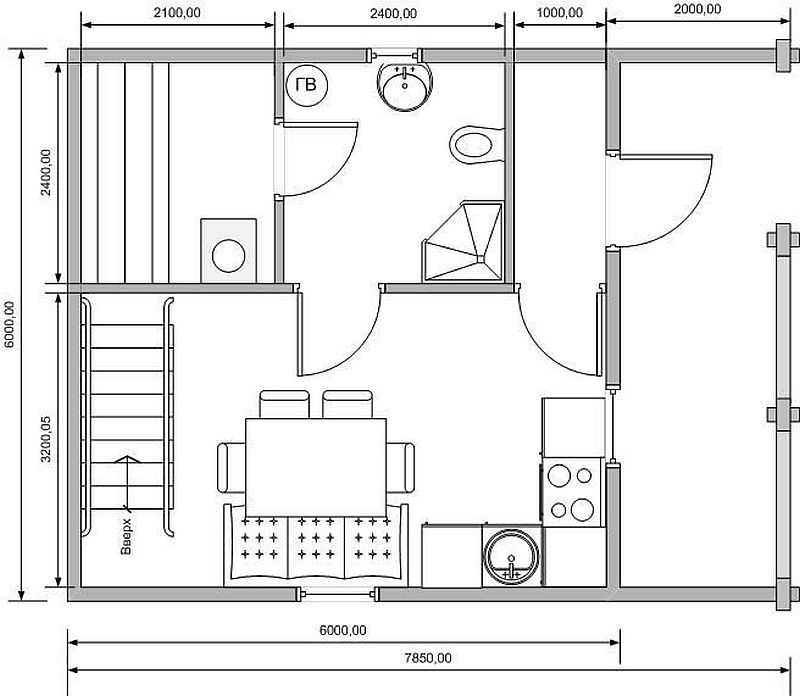
Planning project for the first floor of a two-story timber bath
The areas of the premises are as follows:
- steam room 5 m 2;
- washing 5.8 m 2;
- tambour - 2.4 m 2;
- recreation room 16 m 2;
- terrace 12 m 2;
Plan of a two-story bathhouse 6 by 6 with two entrances
An interesting bath project, suitable for placement on the wide side of the site. There are two porches with attached vestibules. One is used as a boiler room - from there it is heated, the second is used to enter the recreation room. The only drawback in this layout is that the washing room from the steam room is located through the vestibule. Not the best solution: having undressed you will have to go through the room naked, and even the room is cold. To eliminate it, you need to make the boiler room longer, and move the vestibule to the place of the washing room. This will also eliminate the possibility of a strong draft from the two opposite doors.
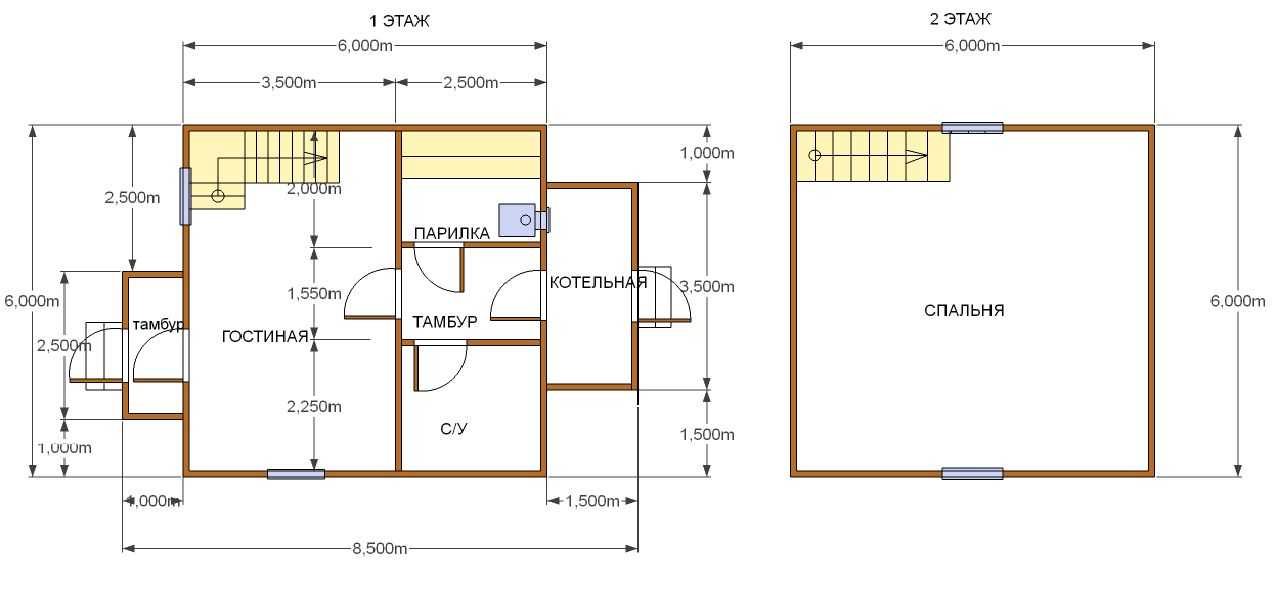
Interesting project of a 2-storey bathhouse with two entrances
In this layout, the areas of the premises are as follows:
- steam room 5 m 2;
- washing 5.6 m 2;
- tambour 1 - 3.9 m 2;
- tambour 2 - 2.5 m 2;
- rest room 21 m 2;
- terrace 12 m 2;
- bedroom on the second floor - 34 m 2;
Layout of a bath from a bar 5 by 5
Due to the fact that 20 cm is spent on creating joints in the corners, "in its pure form" the size indoor spaces will be 5 by 5 meters, and on the outside, for the foundation - 5.4 * 5.4.
In this project, the steam room has a decent size - 2.4 by 2.2 meters. In this version, you can put a corner wide shelf. One person can lie down, and two more can sit. The stove is heated from the rest room, one of the walls goes into the washing room. A rational arrangement that allows you to heat all rooms. The only thing is that the power of the furnace will need to be taken with a decent margin.
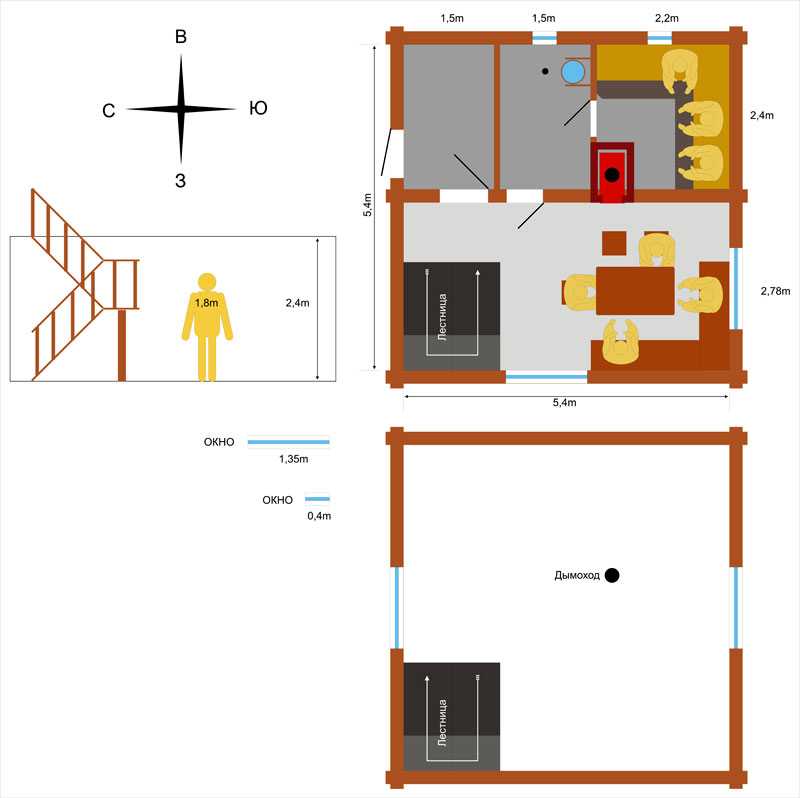
Two-story bath project
The area of \u200b\u200bthe premises in this version of the bath:
- steam room 5.3 m 2;
- washing 3.6 m 2;
- tambour - 3.6 m 2;
- rest room 15 m 2;
- bedroom on the second floor 25 m 2
Features of two-story baths from a bar
Before starting the construction of a two-story bath, you will have to think over not only a standard set of questions about insulation and waterproofing, but new ones will be added:
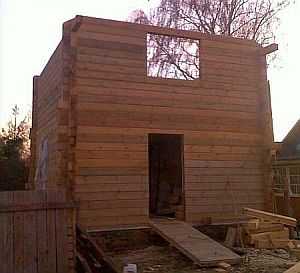
The second floor from timber or logs does not have to be done completely. Having driven it to a certain height, the rest can be “picked up” by the roof. " The result is a bathhouse of one and a half floors ...
- How to make the second floor heating. The most common option is from a pipe sauna stove... But this stove is only heated from time to time, so a second source of heat is needed. This may be a second wood-burning stove, but already a heating one. Moreover, the chimneys must be separate, otherwise the smoke from the upper stove falls down. As a result, both floors are filled with smoke. Electric heaters are often used as a heat source, but this is if there is no power outage.
- Consider a ventilation system or a sealed hatch. If you have a Russian bath, both are better. The steam rises. It needs to be either not allowed to the second floor (hatch) or effectively removed (ventilation system).
And you will also have to decide whether you will make a full-fledged second floor - to expel the walls to the full height. After all, you can make an attic - part of the wall will be made of timber, and part will be covered with a roof. The first option is more expensive, but the second floor is the same area as the first. The second - with an attic - is more economical, but the area of \u200b\u200bthe premises will be smaller due to the roof slopes.

If you decide to make an attic, it can also be done in different ways - lay a few crowns - three to five, and the rest of the roof. But then the roof should have a more complex broken structure. The second option - one and a half floors - is when a wall of a meter and a half is erected from a bar, and only then the roof comes. Here you can make a regular gable roof, but with a large slope.
There is an even more economical option: make the first floor from a log house, the second -. And there will be a tree in the bath, and the load on the foundation will not be so great. And it will be warm. An excellent, and even an inexpensive option for a 2-storey bath.
Another advice based on practice: it is better to make partitions inside frame ones. In any case, the one through which the stove will pass (if it is heated from another room). Otherwise, the entire timber will be cut into small pieces, because most often the doors to the steam room go further. As a result, the entire partition consists of small segments, and fastening them so that the fasteners do not interfere with shrinkage (making a casing) is still a hassle.
Layout of a two-story bath
According to the experience of many bath owners, the most optimal size wooden bath - 6 * 6 meters. The point is in the size of the lumber: it is the six-meter beams, boards and other lumber that are considered the standard. Therefore, there are no problems with materials. And the waste is also a minimum.
The second plus of such a bath is that the premises will turn out to be more or less spacious. It only at first glance seems that there will be a lot of area. In real life, having laid out everything on paper on the shelves, taking into account the thickness of the walls and partitions, finishes, you will be amazed that the rooms are completely miniature.
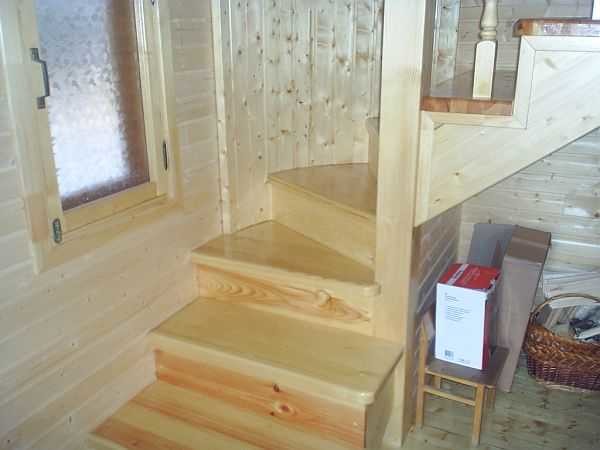
When developing the layout of a soybean bath, do so. Draw a large scale plan of the bath. Draw the walls and walls on the same scale, enter the stairs, draw the stove. And then calculate how much "pure" area will remain. So that it does not come as an unpleasant surprise for you upon construction.
But not everyone can financially "pull" such a construction. Then, based again on the size of the material, there will be less waste in the bath from a 6 * 3 m bar.There are projects for this option, only in this case you will have to either make a combined steam room with a washing room, or move the rest room to the second floor.
On the other hand, you can save on building materials if you build, for example, a 6 * 4 or 6 * 5 bathhouse. All sawn timber shorter than 6 meters are considered non-standard. But this length is also obtained quite often. And this non-standard is sold at prices much lower. Characteristically, the quality of the wood does not deteriorate.
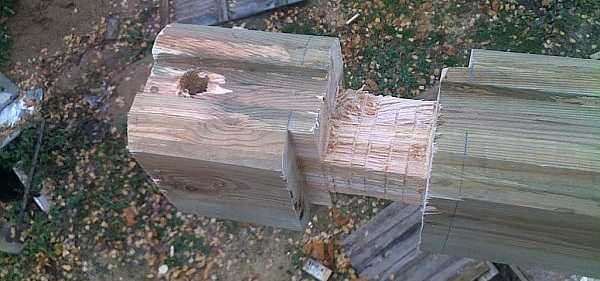
However, quality material of non-standard length must be sought. If you are not afraid of the need to conduct searches, you can save quite a lot. Only one point: it is advisable to buy a standard and a non-standard at the same sawmill - the parameters of a bar or board will be the same. It's not a secret for anyone that there are certain errors in the geometry of sawn timber; not all manufacturers are able to withstand the dimensions with millimeter accuracy. So if part of the material is purchased from one enterprise, and part from another, problems with joining may arise.
For a long time, the bathhouse was only a bathhouse - they steamed in it, washed themselves and occasionally rested. Today, more and more summer residents are choosing a project in which the construction of a steam room combines two functions: a bath room and a living area. And for this, a second floor is often built, on which rooms for rest and sleep are located, taking the first one only for a steam room and a washing room. A terrace, gazebos and outbuildings are also used. The result is only one structure, which has several purposes at once. It is both cheaper and faster to build such a structure than several one-story buildings on one site. In addition, the two-story sauna is perfect for temporary accommodation of guests, as well as for arranging a personal workshop, which is separate from the house.
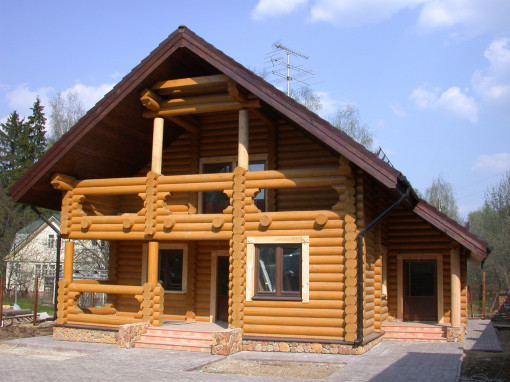
Two-story project wooden house baths can mean the second floor as an additional place to relax.
Projects are presented in the form of a gallery at the end of the article -.
Projects of two-story baths, and even with extensions, are much more complicated. But it is not difficult to build a steam room on them yourself. The main thing is to choose the most successful project of a two-story bath, which will take into account all the features of the area, all the wishes of the household and will guarantee ease and low cost of service. On our site you can find many options for designing a two-story bath. But first, it is important to understand some points for yourself.
Dimensions of the future bath
The size of the bath directly depends on how many people will operate it. If this is a family of 4-5 people, then a small two-story bathhouse made of timber is quite suitable. But if you plan to have periodic rest with friends or you will need to live in such a house for more than one day, it is better to immediately choose a project of a more spacious bath, where even on the second floor there can be several rooms at once: a bedroom, a relaxation room, a fitness room ...
Appointment of the second floor
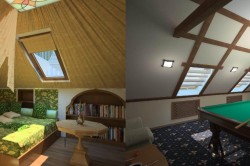
The second floor of the bath can be arranged as a bedroom or a billiard room.
Based on how exactly the second floor of the bath will be used, and you need to choose a project for construction. On the ground floor, it is more advisable to leave only the steam room, washing and dressing room. The recreation room can be equipped either on the terrace or on the second floor.
The room on the second floor can be used as you like: you can make a billiard room, a gym, a tea room, a summer bedroom out of it. But it is becoming more and more popular to make a mini SPA-salon in such a room, which becomes an excellent addition to a steam room and a washing room. For this, a special interior design is used, aromatherapy with healing smells, various vibrating massagers are installed. Therefore, if a small-sized two-story bath project was chosen for construction, it is such a SPA corner that can be equipped in it, turning an ordinary steam room into a whole complex for home improvement.
Pool presence
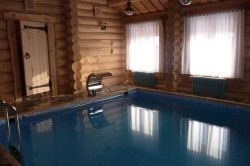
The swimming pool in the bathhouse is made in a separate annex.
In large two-story baths, a swimming pool is often built - this allows the area. Such a pool can be of any measurements and shapes, but it is important to remember that moisture evaporation emanates from simple water, and therefore the waterproofing of the ceiling will be needed in this sector too - so that the living quarters on the second floor do not turn out to be damp.
If the two-story bath is small, then you can choose a bath project with a pool in a special annex. For this, a special room is being built like a veranda next to the bath, using one of its walls as a common one. The walls of this design can be completely glass - this is fashionable even today. But there is another option - a pool under the terrace. For this, special, strong stands are placed in the ground, on which the canopy is attached. And already under a canopy a pool is installed. Thus, you can enjoy cool water after a hot steam room in the fresh air, but not in the open air.
Drainage system
If the bathhouse will be residential even only in the summertime, then it is important to take care of a good drainage system. If the drainage well is close enough to the source of drinking water (main well or shallow well), then all waste and harmful substances from the sewage can easily enter through groundwater into a source of normal water.
It's good if there is a collector nearby - it's easy to cut a pipe into it. As a last resort, you can spend sewer pipe as far as possible from the bath in a special ditch, but for this it is better to take a special permit from the local authorities.
Stairs
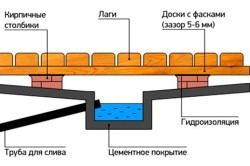
When choosing a project for a two-story bath, it will not be superfluous to pay attention to the design of the stairs. If you plan to visit the bathhouse frequently, the more convenient the stairs are, the better.
The most compact space-saving options are ornate staircases. But climbing them often is not always comfortable. Standard steps are more bulky. But the most unfortunate option, albeit significantly saving space in the bath, is the stairs from the outside of the walls. After being in the steam room, it can even be dangerous to walk through such a structure due to drafts. Therefore, initially it is better to choose a project with a solid and durable ladder that will not stress the spine, and most importantly, will not slip.
Heating system
For a small two-story bathhouse, the ideal heating option is a brick oven. It will warm up rather slowly, but it will give off heat evenly and for a long time. Temperature stability will be maintained in the steam room, and living quarters on the second floor will not overheat. They don't even need to carry out special heating - the pipe coming out of the first floor will warm up the whole room well. It will be enough just to insulate the walls with high quality.
But for a two-story bath of a large area, one stove for winter heating of the entire structure will not be enough. This requires additional heating, and not the worst option is the gas type.
Foundation type
Two-story baths have a more total mass than single-story ones, and therefore involve the construction of a more powerful and deepened foundation. Especially if the bath is built from a fairly heavy material.
Baths of two residential floors are today a tribute modern world, which increasingly strives for practicality and comfort. And you can build with your own hands almost any kind of two-story baths: projects and clear instructions are on our website. All that remains is to buy the necessary building materials and furniture. After all, for a long time such buildings were erected by the owners themselves - without the expensive services of construction companies.
We bring to your attention some projects:
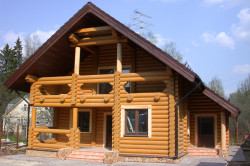
Bath is always good, especially for owners of suburban real estate and land plots. One-story buildings have become a thing of the recent past among those who have more financial capabilities, and among middle-income citizens as well.
After all, today the market building material and ready-made projects is so diverse that you can easily choose any project you like for a bath in 2 floors at a low cost.
In such bath complexes there are much more opportunities than in one-story compact buildings. On the first floor, you can arrange a standard bathhouse, and the second one can be used at your discretion - from the living quarters to the sauna and the pool. Who likes what.
Advantages of a bath complex on 2 floors

Let us examine the question of why the projects of 2-storey baths are so attractive. And the advantages of these buildings are huge. Let's take, for example, the question of the structure of a dwelling on an acquired plot.
Why build 2 independent buildings separately if everything can be easily combined into one common structure? The second floor is a space with all the necessary communications, and the first is a bath complex. And for lovers of a hot sauna and a large space for receiving guests, the project of a 2-storey bath is especially suitable.
Some advantages of such a structure
The most visible advantages include the following:
- Compactness of premises... Indeed, on one site, a two-story bath takes up a smaller area than a one-story building with the same total area.
- The building itself in 2 floors can include not only a bathhouse, but also a sauna, a swimming pool, rest rooms or living quarters.
- External decoration, and the whole view of such a bath looks much more solidthan a one-story small bathhouse.
It is also worth noting the fact that it is not as difficult to do this complex with your own hands as it might seem. It is enough to draw up a plan in advance, invite designers, if you yourself do not know how to design correctly. Also, purchase all the material and hire a construction team or call friends and relatives for help, but only if they are competent in the construction issue.
In general, it is now easy to buy any ready-made project of a 2-storey bathhouse, and the price for it depends on the service provider and the material of manufacture - timber, foam blocks, etc. Each of them has its own advantages somewhere in terms of price and somewhere in terms of quality.
Well, of course, it remains indisputable that the best bath is a bath made of timber, because the tree "breathes" and gives its own smell, as well as healing properties.
Tip: projects of 2-storey baths can be realized independently, but only from the lightest material - foam blocks.
It is better to entrust this action from a bar and other building material to specialists, since you can ruin everything by deciding to save on labor.
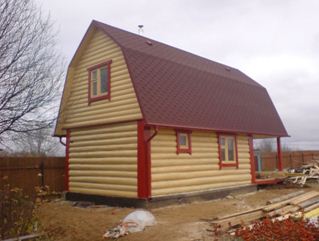
Bath - house
How to place communications in a bath complex
Any engineering systems and communications in a two-story bathhouse differ significantly from an ordinary steam room, not only in their purpose, but also in complexity. There is a definite instruction about where and what to lay, what to connect with and where what goes.
But for ordinary citizens this is alien and it is better to call experienced specialists who will correctly distribute and place everything in your future bath complex.
What you need to know:
- The interfloor overlap is not as dense as in an ordinary house, since the second tier is heated by steam coming from the first floor.
- During the time when the bath is not functioning, heating radiators are installed, which greatly facilitates heating the entire room.
- If people live in the bathhouse even in winter in those premises that are used as living quarters, then a separate boiler room is simply necessary.
- The best option is the location on the ground floor of the entire bath complex, depending on the area with different communications - a sauna, a swimming pool, a steam room, a washing space, a shower, a bathroom, and perhaps even. On the second floor, most often people simply live, sometimes all year round.
Advice: if you like the projects of 2-storey saunas, then it is better to opt for a house with an attic or to occupy the second floor with living quarters.
These models are shown in the photo, and you can easily understand all the advantages of such buildings, where the bathhouse and the house create one common, indivisible structure with all the amenities.
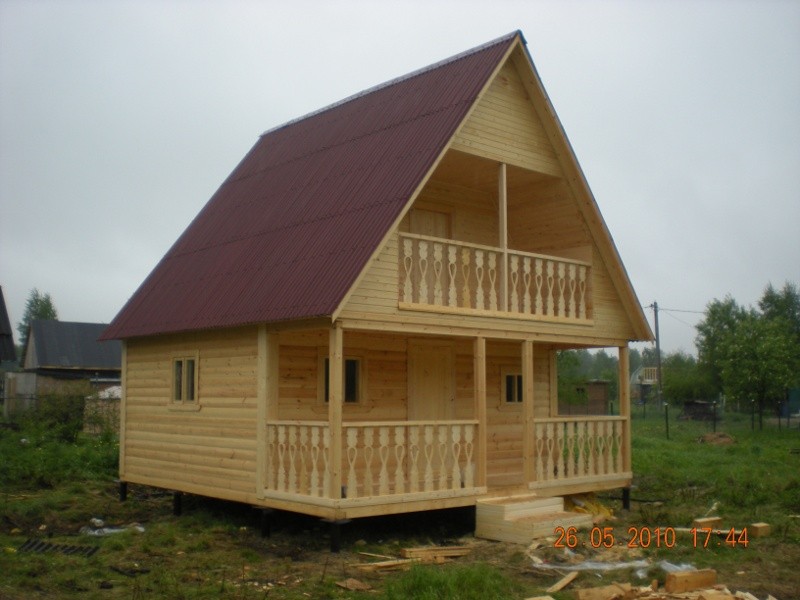
We place all the little things in the bath
It is possible and necessary to install a shower in your future or already built sauna, if there is no pool. Also, do not forget about the bathroom, even if it is on the second floor, one does not interfere with the other. If you decide to use the second floor for living, then in any case the rest room on the first has a place to be.
Some especially large buildings also have a kitchen on the ground floor, which is convenient for receiving guests and does not have to use your house as a service area. The photo clearly shows how the space is distributed in one of the projects of 2-tiered bath complexes.
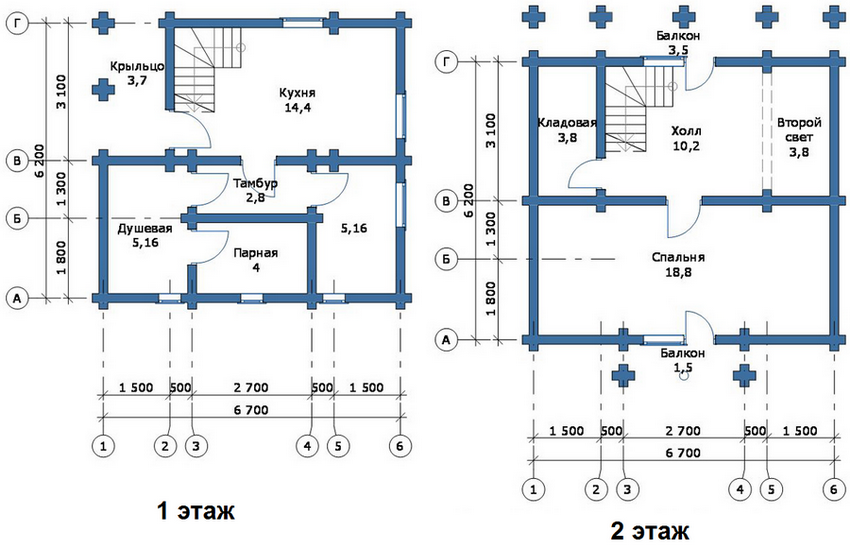
Advice: how and where to put a hot tub or install a steam room is everyone's business, but in finished projects usually publishers immediately offer their solution to this issue, so you can listen to their opinion.
If you don't like something, then everything can always be regulated and redone in your own way during the construction process.
We advise you to immediately decide what you want to get from your bathhouse.
Outcome
From all of the above, we can conclude that projects of baths on 2 floors have a great advantage over one-story buildings. After all, not only the area occupied on the site is saved, but also the building material itself.
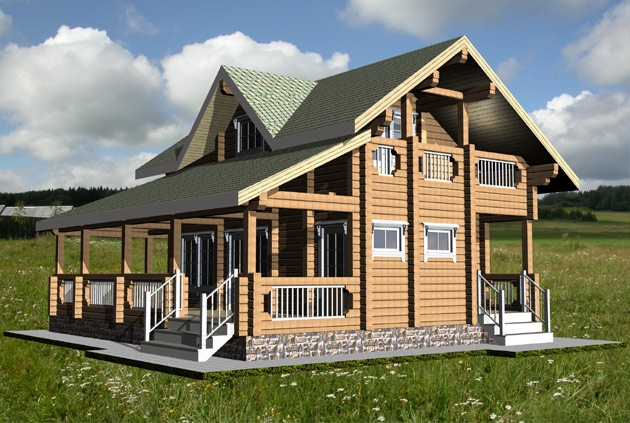
The most popular today are baths made of glued beams and logs, since wood is always held in high esteem. Also, do not forget that if you wish, you can do everything yourself, of course, if your level of knowledge in this area of \u200b\u200bconstruction is large enough. On the issue of the distribution of communications and other equipment in the room, it is still better to get the most competent advice.
In the video in this article, you will see a lot of interesting things about the construction and arrangement of two-story baths, and maybe this will give you ground for thought. Successful construction.
Projects of two-story bathspresented on this page differ both in area and in architectural design. Despite this, two-story timber baths combine properties such as environmental friendliness of the material, coupled with functionality and the ability to relax in the fresh air.
Vector color solutions for two-story baths from a bar it is very diverse: both "gingerbread" baths and laconic buildings, designed in classics of pastel colors, are presented here. Due to the fact that the timber does not require additional finishing, all external design of the baths is reduced to a minimum: do not give finishing material drown out the beauty and naturalness of the tree.
Projects of two-story baths also presuppose the presence of obligatory premises: rest rooms, washing and steam rooms. The steam room is always located in the depths of the building, which is provided for the purpose of keeping hot steam and heat inside the bath. In addition to the obligatory rooms, the layouts of the baths provide for an additional room on the second floor to ensure leisure. Attic floors Baths are often set up as a room for having a good time after the steam room: a billiard or tennis table, armchairs, coffee tables for coffee or tea with friends, or even small exercise machines for combining business with pleasure will be acceptable. Broken roofs baths allow you to expand the space on the second floor and equip it as a sleeping room. Projects of two-story baths with attic floor also perform the functions of a guest house when placing a sufficient number of beds and interior elements for relaxation.
Two-storey sauna with a terrace or a large veranda will provide cultural relaxation not only in a specially designated recreation room, but also outside the bath: a table with armchairs, a couch and even couches will fit perfectly here. How pleasant it is to leave the steam room on the terrace, take a breath of clean air and sit down at a table with friends or with your family and enjoy nature. The layout of some baths provides for the area of \u200b\u200bterraces and verandas larger than the footage of the internal rest room: this will make it possible to realize all the plans of the owners regarding leisure for both adults and children. In some projects of two-story baths there are balconies on the second floor, where you can place a hammock or a rocking chair for lovers of secluded relaxation.
IN projects of two-story baths from a bar with a terrace a porch, recessed or built-in, can be laid, but the absence of a porch at the terrace is not a losing one. Be it classic, austere or modern in design two-story baths, not a single project will leave indifferent users due to competent planning and functionality.
Pay special attention to themselves two-storey log baths... Looking at such a structure, one feels like in an older world, when log baths and houses were everywhere, except that these projects are being carried out using the latest technologies in construction. Each project has its own individual characteristics, just as one person differs from the other in his personality. Such projects are attracted due to the capital and reliability of buildings.



